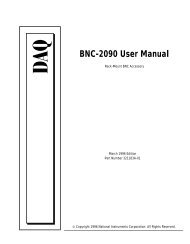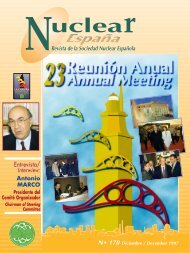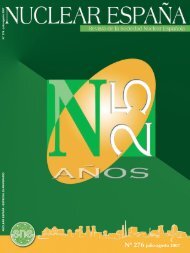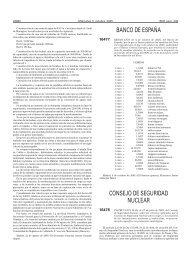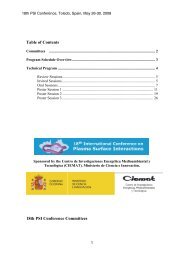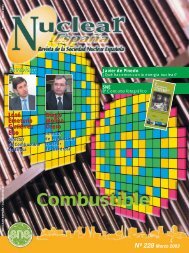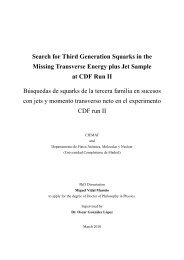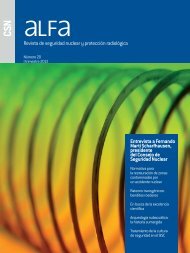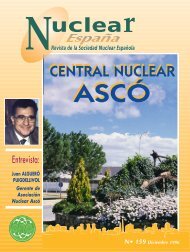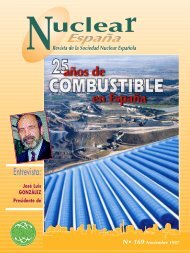EntrEntr evista/evista/ InterInter viewview
EntrEntr evista/evista/ InterInter viewview
EntrEntr evista/evista/ InterInter viewview
Create successful ePaper yourself
Turn your PDF publications into a flip-book with our unique Google optimized e-Paper software.
111 MW increase at the end of the year. I should like<br />
to point out that these figures are based on the results<br />
of the homologation tests performed by these plants,<br />
and that as of the end of the year these were partly<br />
still undergoing administrative arrangements with<br />
the Ministry of Industry and Energy, for their formal<br />
recognition. We use these values because they<br />
reflect the technical reality of the facilities, and in<br />
order not to favourably distort the results of operating<br />
indicators in which rated power plays a part, to<br />
which I shall refer below.<br />
The load factor, which relates actual production to<br />
that technically possible, has reached 87.4% for the<br />
plants overall, thus maintaining the trend shown<br />
over the last decade, in which this factor has been<br />
above 85%.<br />
The operating factor, which indicates the time that<br />
the plants have been coupled to the grid, regardless<br />
of the power level at which they have been<br />
operating, reached 90%, also the second highest<br />
value ever attained by the Spanish nuclear power<br />
plants overall.<br />
For its part, the availability factor has been 88.5%.<br />
The difference between this parameter and the load<br />
factor is that in this case no consideration is given to<br />
the losses or gains in production due to causes not<br />
under the control of the operating personnel, such as<br />
grid load rejections or improvements in performance<br />
due to environmental causes. For this reason, within<br />
the new framework that has governed the electricity<br />
industry for the last two years, this factor becomes<br />
especially relevant in analysis of the technical<br />
performance of the installations.<br />
The scheduled and non-scheduled unavailability<br />
factors have amounted to 9% and 2.6%,<br />
respectively. The first is higher than the figure<br />
recorded in 1998 due to the larger number of<br />
refuelling operations carried out, while the second is<br />
significantly lower than that registered the previous<br />
year, which was 6%.<br />
The average value for non-scheduled reactor trips<br />
has slightly increased during 1999. The figure for<br />
automatic non-scheduled trips (scrams) has been 1.7<br />
per reactor, and the total figure for non-scheduled<br />
shutdowns, both manual and automatic, has been<br />
2.8. Nevertheless the high level of training and the<br />
operating experience of the operators have made it<br />
possible for the plants to return to power operation<br />
shortly after these trips.<br />
The studies on operations and maintenance costs<br />
for 1998 have not yet been completed, but the<br />
decreasing trend shown during the period 1993-<br />
1997, to which I referred last year at this same<br />
forum, is expected to continue. It should be<br />
remembered that in 1997 these figures stood at 1.26<br />
pesetas/kWh net (approximately 0.84 cents), in line<br />
with the most efficient plants in the world.<br />
In completing and updating the habitual data, I<br />
shall point out that the total nuclear electricity<br />
generating capacity amounted to 7,749.1 MW as of<br />
31st December 1999. As already explained, this<br />
represented an increase of 111 MW with respect to<br />
the previous year, and 16.7% of the total installed<br />
capacity of the UNESA member companies.<br />
It is a pleasure for me to be able to repeat yet<br />
another year that Spain’s nine nuclear units continue<br />
to show excellent performance as regards safety,<br />
availability and costs, maintaining the trend<br />
established in previous years and underlining the<br />
high level of qualification of the professionals who<br />
make this possible. The reliable, safe and economic<br />
performance of the nuclear power plants is the best<br />
possible argument in favour of nuclear power<br />
continuing to be used in the future as a source of<br />
electricity supply in our country, throughout the<br />
operating lifetime of each of the facilities.<br />
Mention should be made of the fact that this year<br />
the José Cabrera, Garoña and Trillo plants have had<br />
their Operating Licences renewed after the Nuclear<br />
Safety Council (CSN), the maximum national<br />
• Real Decreto Ley 6/1999 de 16 de Abril<br />
• Royal Decree-Law 6/1999, April 16<br />
• Consumidores cualificados<br />
• Qualified Consumers<br />
A/At 31-12-99<br />
Apartir de/As of 1-7-00<br />
• Nuevos Agentes Autorizados<br />
• New Authorized Agents<br />
EDF, REN, Electrabel, ONE<br />
Aare-Tessin, Eastern Group, Enron Energy<br />
señalar que en el año en que se alcanzó<br />
su máximo (1998), sólo 4<br />
centrales efectuaron la recarga de<br />
combustible, frente a las 7 que la<br />
han realizado en 1999. Esta diferencia,<br />
significativa en el tiempo total<br />
de conexión a la red, únicamente<br />
ha tenido una repercusión del<br />
0,25% en la disminución de la producción.<br />
Esta aparente discrepancia se justifica<br />
por la mejora alcanzada en las<br />
potencias nominales de Vandellós II<br />
y de la unidad II de Ascó, que han<br />
supuesto un incremento total de 111<br />
MW a final de año. Quiero aclarar<br />
que estas cifras están basadas en los<br />
resultados de las pruebas de homologación<br />
realizadas por dichas centrales,<br />
si bien parte de ellas estaban<br />
a final de año en tramitación administrativa<br />
con el Ministerio de<br />
Industria y Energía para su reconocimiento<br />
formal. Utilizamos estos valores<br />
por que son los que responden<br />
a la realidad técnica de las instalaciones<br />
y para no distorsionar favorablemente<br />
los resultados de los indicadores<br />
de funcionamiento en los<br />
que interviene la potencia nominal,<br />
a los que me referiré a continuación.<br />
El factor de carga, que relaciona<br />
la producción real con la técnicamente<br />
posible, ha alcanzado el<br />
87,4% para el conjunto de las centrales,<br />
manteniéndose la tónica de<br />
la última década en que este factor<br />
ha sido superior al 85%.<br />
El factor de operación, que indica<br />
el tiempo en que las centrales han<br />
22% ejerciendo/practicing<br />
54% del mercado/of market<br />
estado acopladas a la red, independientemente<br />
del nivel de potencia al<br />
que hayan estado funcionando, ha<br />
alcanzado un valor del 90%, que<br />
también constituye el segundo valor<br />
máximo alcanzado por el conjunto<br />
del parque electronuclear español.<br />
El factor de disponibilidad, por su<br />
parte, ha sido el 88,5%. Su diferencia<br />
con el factor de carga estriba en<br />
que en él no se tienen en cuenta las<br />
pérdidas o ganancias de producción<br />
originadas por causas que no están<br />
bajo control del personal de operación,<br />
como pueden ser los rechazos<br />
de carga de la red eléctrica o las<br />
mejoras de rendimiento por causas<br />
medioambientales. Por ello, en el<br />
nuevo marco en que se desenvuelve<br />
el Sector eléctrico desde hace dos<br />
años, este factor adquiere especial<br />
relevancia al analizar el funcionamiento<br />
técnico de las instalaciones.<br />
Los factores de indisponibilidad<br />
programada y no programada han<br />
sido del 9% y 2,6% respectivamente,<br />
el primero, superior al del año<br />
1998 por el mayor número de operaciones<br />
de recarga efectuadas y, el<br />
segundo, significativamente inferior<br />
al de dicho año que fue del 6%.<br />
El valor medio de las paradas no<br />
programadas del reactor que se han<br />
producido ha tenido un repunte en<br />
el año 99. El correspondiente a las<br />
paradas automáticas no programadas<br />
(disparos) ha sido de 1,7 por reactor<br />
y el del total de paradas no<br />
programadas, automáticas y manuales,<br />
ha sido de 2,8. No obstante, la<br />
A b r i l 2 0 0 0<br />
R e v i s t a S N E




